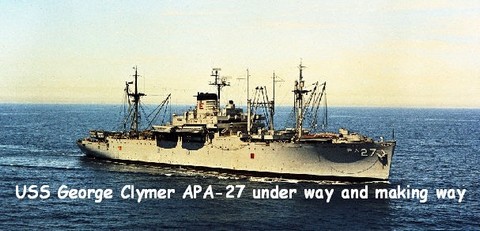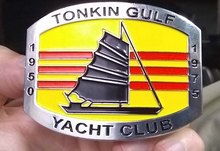 |
|||||||||||||||||||||||||||||||||||||||||||||||||||||||||||||||||||||||||||||||||||||||||||||||||||||||||||||
 |
|||||||||||||||||||||||||||||||||||||||||||||||||||||||||||||||||||||||||||||||||||||||||||||||||||||||||||||
| For RATING SHIRTS - Click on your Rating Abbreviation below: | |||||||||||||||||||||||||||||||||||||||||||||||||||||||||||||||||||||||||||||||||||||||||||||||||||||||||||||
|
|||||||||||||||||||||||||||||||||||||||||||||||||||||||||||||||||||||||||||||||||||||||||||||||||||||||||||||
| Click on your Rating abbreviation above: | |||||||||||||||||||||||||||||||||||||||||||||||||||||||||||||||||||||||||||||||||||||||||||||||||||||||||||||


U.S.S. GEORGE CLYMER
(APA-27)GREASY GEORGE
Click to view crew list
USS GEORGE CLYMER (APA-27 ) - an Arthur Middleton-class attack transport
In Commission 1942 to 1966APA-27 Deployments - Major Events
| Add a APA-27 Shellback Initiation | Add a APA-27 Deployment - Major Event | ||||
| Month | Year | to | Month | Year | Deployment / Event |
|---|---|---|---|---|---|
| OCT | 1940 | - | Keel Date: 28 OCT 1940 at Ingalls Shipbuilding Pascagoula MS | ||
| SEP | 1941 | - | Launch Date: 27 SEP 1941 | ||
| JUN | 1942 | - | Commissioned: 15 JUN 1942 | ||
| OCT | 1942 | - | DEC | 1942 | Middle Atlantic - North Africa |
| JUN | 1955 | - | APR | 1956 | West Pac |
| JAN | 1960 | - | AUG | 1964 | West Pac-Viet Nam |
| AUG | 1962 | - | JAN | 2009 | By By George at Naval Base San Diego |
| SEP | 1962 | - | MAR | 1963 | West Pac |
| APR | 1964 | - | Shellback Initiation - 15 APR 1964 - Pacific Ocean | ||
| MAY | 1965 | - | Shellback Initiation - 5 MAY 1965 - Pacific Ocean | ||
| MAY | 1965 | - | AUG | 1965 | West Pac-Viet Nam |
| FEB | 1966 | - | SEP | 1966 | West Pac-Viet Nam |
| JUN | 1966 | - | Shellback Initiation - 19 JUN 1966 - Pacific Ocean | ||
| OCT | 1967 | - | Decommissioned: 31 OCT 1967 | ||
APA-27 General Specifications
Class: Arthur Middleton-class attack transport
Named for: George Clymer
Complement: 578 Officers and Enlisted
Displacement: 9 tons
Length: 491 feet
Beam: 69.5 feet
Flank Speed: 18 Knots
Final Disposition: Sold for scrap 26 July 1968
USS GEORGE CLYMER (APA-27)
George Clymer (AP-57) was laid down as African Planet under Maritime Commission
contract 28 October 1940 by Ingalls Shipbuilding Co., Pascagoula, Miss.; launched 27 September 1941; sponsored by Mrs.
Kathryn Stapleton; renamed George Clymer 9
January 1942; acquired by the Navy 15 June 1942; and commissioned the same day, Captain Arthur T. Moen in command.
George Clymer sailed 21 June via Charleston to Norfolk where she arrived 30 July for training in
Chesapeake Bay. She embarked 1,400 men of the 9th Infantry Division and departed
23 October for the amphibious invasion of French Morocco. After joining Rear
Admiral Monroe Kelley's Northern Attack Group off the Moroccan coast 7 November, at midnight 8 November she debarked assault
troops on special net-cutting and scouting missions against garrisons at Mehedia and the fortress Kasba. Just
before dawn the first wave of troops
hit the beach and encountered
resistance from the Vichy French. Enemy shore batteries fired on the assembled
transports and straddled George Clymer before she opened the
range. Hard fighting continued ashore until 11 November. George Clymer debarked troops, unloaded cargo, and treated
casualties until 15 November when she sailed to Casablanca to complete off-loading cargo. She departed for the United
States the 17th, arriving Norfolk 30
November.
After embarking more
than 1,300 Seabees, George Clymer sailed 17 December for the Pacific.
One of the first transports to serve in both
the Atlantic and Pacific, she reached Noumea, New Caledonia, 18 January
1943; sailed 23 January for the Fiji Islands;
and arrived Espiritu Santo, New
Hebrides, 30 January. Redesignated (APA-27) on 1 February, she sailed in convoy 5 February for Guadalcanal, Solomons, where she arrived the 7th
to debark reinforcements and embark
casualties and Japanese prisoners of
war. During almost the next 9 months she
sailed the Southwest Pacific, carrying cargo and rotating troops from
bases in New Zealand, New Caledonia, the New
Hebrides, and the Fijis to Guadalcanal. On 19 April she evacuated 38 Chinese and Fijian women and children, who had
hidden from the Japanese for more than a
year, from Gaudalcanal and transported them to Noumea.
As
flagship of Rear Admiral T. S. Wilkinson's 3d Amphibious Force, George Clymer departed
Guadalcanal 30
October for the invasion of Bougainville. Closing Cape Torokina 1 November, she
debarked men of the 2d Marine Raider Battalion before joining other transports in a combined bombardment of
enemy positions on Cape Torokina. She returned to Port Purvis, Florida Island, 3 November; and during the
next 2 months she made three runs to Bougainville, carrying reinforcements and
cargo from the Fijis and Guadalcanal.
George Clymer continued troop-carrying and supply runs in the Southwest Pacific
until 4 June when she departed Guadalcanal for the invasion of the Marianas. Steaming via Kwajalein, she
operated off Saipan from 17 to 30 June while serving as flagship of Rear Admiral L. R.
Reif-snider's
Southern Attack Group. She reached Eniwetok 4 July; departed 17 July for the assault against
Guam; and arrived
off Agat 21 July. After debarking assault troops, she served as receiving ship, boat pool
tender, and medical station for the Southern
Transport Group. She remained at Guam
until 20 August; steamed via Saipan to Hawaii; and arrived Pearl Harbor 31 August.
Underway
again 15 September, George Clymer steamed via Eniwetok and Manus, Admiralties, to the
Philippines, where she landed
nearly 1,000 troops at Dulag 21 October during
the invasion of Leyte. She returned to Manus 28 October; and, following a troop and cargo-carrying mission to New
Britain and back, she sailed 11 November for the
United States and arrived San Francisco 3 December for overhaul. Sailing 26 January 1945, she reached
Guadalcanal 11 February and for more
than a month trained for the invasion
of Okinawa. She departed Ulithi, Carolines, in convoy 27 March; arrived off
Hagushi 1 April; then debarked troops
and unloaded cargo before departing 5
April. Steaming via Saipan and Pearl Harbor, she arrived San Francisco 9 May.
After
conversion to a transport squadron and relief amphibious force flagship, she
transported 1,200 Seabees to Pearl Harbor from 21 to 27 July. After returning to San Francisco 5 August with wounded veterans
embarked, she sailed 12 August for the
Philippines. She reached Manila 7 September; embarged nearly 1,000
occupation troops of the 33d Infantry
Division; and transported them to
Japan, arriving Wakayama 25 September. Between 3 and 21 October she made a similar voyage from Leyte to Japan; then, as part of the
"Magic-Oarpet" fleet, between 31 October and 14 November she
carried more than 1,200 veterans from Saipan
to San Francisco. Between 27 November and 28 December she cruised to
Guam and Saipan and returned to San Pedro
with homebound troops.
Prior
to the outbreak of Communist aggression in Korea, George Clymer supported various naval
operations in the
Pacific. From 1 June to 20 August she served at Bikini Atoll as flagship for Transport Division 11
during atomic
bomb tests in the Marshall Islands. She conducted training operations along
the Pacific coast until 15 December 1947 when she departed San Pedro for the Far East. Arriving Tsingtao,
China, 20 January 1948, for more than 6 months she operated along the Chinese coast supporting the
Nationalist Chinese troops during the Chinese Civil War. She departed Tsingtao 5 August; embarked troops at Guam;
and transported them via the Panama Canal to Morehead City, N.C., where she arrived 17 September.
George Clymer returned to San Diego 4 October, and during the next 19
months she operated off the coast of Alaska, the West Coast, and in Hawaiian waters.
After the invasion of South Korea
by North Korean troops, she departed San
Diego 14 July and carried units of the 5th Provisional Marine Brigade to Pusan, South Korea, where she debarked
them 2 August to help stem the Communist advance at Masan. After returning to Yokosuka, Japan, 7 August, she embarked men of the 1st Marine
Division at Kobe for the amphibious
invasion at Inchon 15 September. Following the successful landings, she served
as amphibious control and hospital
ship before returning to Sasebo 29
September with casualties. She returned to Inchon 8 October to embark marines,
and on 17 October she sailed for
Wonsan, where she landed troops the 25th. Departing Wonsan 30 October, she
steamed via Yokosuka to the United
States and arrived San Diego 24 November.
George Clymer departed San Diego 4 June 1951; and, after embarking troops at
San Francisco, she sailed 6 June for the Far East, arriving Yokosuka 20 June. During the next 10 months
she supported the effort to repel Communist aggression in Korea; participated in amphibious landings along
the Korean coast; rotated troops between Japan and Korea; and cruised Far Eastern waters from the Sea of
Japan to the South China Sea to meet the demands of military forces in Asia. On 15 October she rescued nearly
500 survivors from the Japanese merchantman, Kongo Maru, caught during a
typhoon at
Uku Shima, Japan. She departed Yokosuka 1 April 1952; returned to the United States for 7 months;
then sailed
from San Diego 12 November for a third deployment off Korea. After reaching Yokosuka 29
November, she
took part in troop-rotation runs between Korea and bases in Japan, Okinawa,
and the Philippines. On 27 July 1953, as the armistice which brought an uncertain peace to Korea was signed
at Panmunjom, she departed Yokosuka for the United States, arriving San Diego
22 August.
Since
the termination of hostilities in Korea, George Clymer has deployed to the Far
East on numerous occasions as an important unit of the always-ready force for peace, the 7th Fleet.
Capable of carrying combat-ready troops to any beach in the Western Pacific and Southeast Asia, she had provided
vital support during the continuing struggle to meet and repel Communist aggression. Whether in the
Strait of Formosa, the Gulf of Tonkin, or along the coast of Vietnam, she has remained ready to intervene
promptly and powerfully whenever needed. In August 1964 she cruised the South
China Sea in
an advanced state of readiness following the Gulf of Tonkin incident. During
the summer of 1965 she deployed to South Vietnam, where she participated in amphibious landings at Da
Nang and Ohu Lai. At present she continues to bolster the American effort to thwart Communist aggression in
South Vietnam.
George Clymer received five battle stars for World War II and seven battle stars for Korean conflict service.
[Note: The above USS GEORGE CLYMER (APA-27) history may, or may not, contain text provided by crew members of the USS GEORGE CLYMER (APA-27), or by other non-crew members, and text from the Dictionary of American Naval Fighting Ships]
